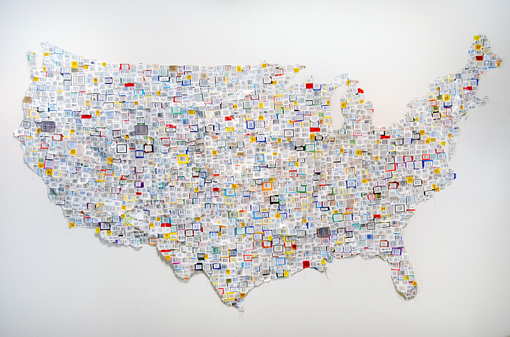Branded
Stephen Andrews, Catherine MacTavish, Janet Morton
February 4 - March 5, 2005

When Branded first came together as a concept for a group exhibition the initial selection of works - and there were three - each embodied a distinct aspect of the word. Morton's map of the United States, entitled Trust and comprised of over 2,000 stitched together bar codes, spoke to consumerism and brand consciousness. Stephen Andrew's drawing of a bombed Iraqi horizon, untitled (the Mickey Mouse explosion), presented a looming Disneyland icon that, in Andrew's words, “signals the arrival of the Americans”. And MacTavish's Skin Deep touched on a branding of the personal, self-inflicted kind.
The precursor to Skin Deep is Arms Race, a painting MacTavish produced in 1984 that was installed as an acquisition by the Art Gallery of Ontario for several months in 2004. As its title suggests, the surface is lacerated with patterns of missile fire and attack while at the same time suggesting the skin of flayed and bruised flesh.
Skin Deep alludes to surface — the physical properties and formal attributes that form an additional network of connections and an expanded field of choices. Andrew's drawing sequence Balloon, while providing a metaphor for “the big bang,” builds towards an even dispersion of pictorial elements. This idea is found throughout the show and captured in its essence with Andrew's A Small Part of Something Larger #5 (Frozen). The dots found in four-colour offset print reproduction technology bleed out at the edges of either an arrested field of off-register post-nuclear space, a free zone of brand war indifference or the veil (veneer?) that branding brings to product information and the consumer psyche. The wind and water patterns stitched onto bar codes in Janet's work Weather Warning is suggestive of green capitalism and the marketed appropriation of made-topical environmental issues as political devices.
And, finally, MacTavish's Drawing For People Looking For Messages addresses an audience of viewers “who want to put art into words, who are looking for messages, like advertisements” to quote the artist - brand names rather than experience. And in this composition we see cluster forms of ideas at various levels of psychic penetration - a mapping of consciousness - where the branding of information finds reception, critical or otherwise.
Paul Petro
